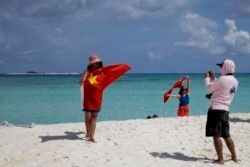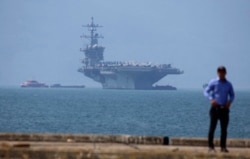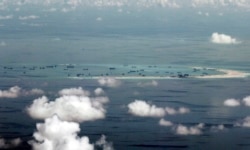On January 7, the state-run China Daily newspaper posted a propaganda video accusing the United States of using “so-called freedom of navigation operations to provoke China and destabilize the region.”
The video, titled “U.S. Navy threatens livelihoods in South China Sea,” prominently features a Chinese fisherman it describes as “being one of many fishermen who have witnessed the U.S. Navy flexing its muscles.”
The fisherman claims U.S. vessels destroy the buoys and nets of Chinese fishermen. It also speculates about the USS Connecticut (SSN-22), a Seawolf-class nuclear attack submarine damaged last October in a collision with an underwater mountain in the South China Sea.
In the video, a Chinese military expert, looking at a satellite image, claims a nuclear leak cannot be ruled out, reiterating a Chinese Foreign Ministry talking point. The Chinese Foreign Ministry has repeatedly tried to use the sub incident to undermine U.S. freedom-of-navigation operations in the region.
Asked about the incident, the fisherman in the video claims that a nuclear leak could damage the marine ecosystem, which sustains his livelihood. One commentator in the video states claims the real U.S. goal is to preserve dominance in the region, not freedom of navigation.
This is all nonsense.
In fact, it is China, not the United States, which has repeatedly used military force against fishermen and maritime vessels in the region. Those actions, in tandem with China’s sweeping and illegal maritime claims, are what prompted U.S. freedom-of-navigation operations.
The video’s depiction of a lone, struggling fisherman bears no resemblance to the realities of China’s vast fishing fleet, which is notorious for its aggressive tactics, including ramming competitors and foreign patrol ships.
China has sent warships to escort illegal fishing expeditions – actions that some analysts have warned could lead to armed conflict.
Despite China's protests of U.S. vessels operating in international waters in the South China Sea, Chinese fishing vessels have systematically engaged in illegal fishing, particularly off of the coast of South America, imperiling their ecosystems.
Chinese ships have also been accused of turning off their GPS tackers in order to illegally fish around protected waters outside of the Galápagos Marine Reserve near Ecuador’s exclusive economic zone, Seafoodsource.com reported.
It is also Beijing that is threatening peace in the South China Sea through aggressive actions against its neighbors.
For example, last November, Chinese coast guard ships deployed water cannons to stop Filipino ships from delivering food to Filipino troops on Second Thomas Shoal in the Spratly Islands, located in the eastern part of the South China Sea.
The Philippines called the actions of China’s coast guard illegal and asked it to “back off.”
In 2016, an international tribunal in The Hague, which has rebuked many of China’s sweeping claims to the South China Sea, ruled that Second Thomas Shoal is part of the Philippines' continental shelf and lies within its Exclusive Economic Zone (EEZ).
The United Nations Convention on the Law of the Sea recognizes the 200-nautical mile stretch of sea from the coast of a state as its EEZ. But China has ignored The Hague’s ruling, and continues to illegally blockade the shoal.
In 1994, China also seized nearby Mischief Reef, which The Hague also ruled is part of the Philippines’ continental shelf. And China seized the Scarborough Shoal, some 137 miles east of the Philippines’ island of Luzon, and has captured islands and reefs from Vietnam.
The November incident between the Filipino ships and China’s coast guard was not isolated.
As Polygraph.info and others have reported, China has sunk Vietnamese fishing boats near the Paracel Islands, another disputed South China Sea archipelago. An April 2020 attack on a Vietnamese fishing boat drew a protest from Hanoi, which Beijing ignored. Two months later, the Chinese Coast Guard attacked another Vietnamese vessel.
China has also used military force to prevent Vietnam and Malaysia from carrying out exploratory activities within their claimed EEZs.
Last February, the Voice of America reported that China passed a law granting its Coast Guard the power to fire on foreign ships in the South China Sea, the stated goal being, among other things, safeguarding its “maritime rights and interests.”
The move puts countries like Brunei, Malaysia, the Philippines, Taiwan and Vietnam, all of which have competing claims in the South China Sea, in the crosshairs.
This week, the U.S. State Department’s Office of Ocean and Polar Affairs, Bureau of Oceans and International Environmental and Scientific Affairs released a report covering China’s attempts to assert maritime dominance in the region.
It found that China “unlawfully claims sovereignty or some form of exclusive jurisdiction over most of the South China Sea” and that those claims “gravely undermine the rule of law in the oceans and numerous universally recognized provisions of international law reflected in [UNCLOS].”
The report covers many illegal Chinese actions, including Beijing’s drawing of “straight baselines” that “enclose the islands, waters, and submerged features within vast areas of ocean space in the South China Sea.”
According to the United Nations, straight baselines “[join] the outermost points of the outermost islands and drying reefs of the archipelago.” Those baselines are used to determine the territorial waters of archipelagic states.
However, the United States and outside experts have argued that China, as a continental state, cannot draw baselines around entire dispersed island groups, thereby claiming the waters around them as their own.
The report also refers to the 2016 South China Sea Arbitration at The Hague, which covered the so-called “nine-dash line,” a boundary imposed by Beijing that Beijing claims gives China control over most of the South China Sea.
The Hague found that China’s claims regarding the nine-dash line “are contrary to [UNCLOS] and without lawful effect to the extent that they exceed the geographic and substantive limits of China’s maritime entitlements under the Convention.”
British journalist and scholar Bill Hayton found the U.S. report to be “very good … clear, balanced, based on good evidence and well argued.”
He tweeted that the report “will be a standard reference for future discussions on the legality of China's claims in the South China Sea.”
Meantime, China’s reaction to the USS Connecticut’s underwater collision has been linked to a trilateral defense partnership between Australia, the United Kingdom.
Alexander Neill, a defense and security consultant based in Singapore, told the Voice of America’s sister organization Radio Free Asia (RFA) that China was “playing up the risks” of the USS Connecticut incident, as it came roughly two weeks after Australia, the United Kingdom, and the United States announced the creation of the AUKUS defense pact.
AUKUS, among other things, entails the delivery of a nuclear-powered submarine fleet to Australia.
“In the light of AUKUS and China’s anti-AUKUS narrative, [the Connecticut incident] is a windfall for Beijing, perfect for the narrative that the U.S. and allies are nuclearizing the South China Sea and violating counter proliferation regimes,” Neill told RFA.
Neil added there was no nuclear leak or damage to the USS Connecticut’s nuclear propulsion system, reiterating a statement made by the U.S. Navy days after the incident.
Purported concerns over the USS Connecticut incident have not stopped China from ramping up its own nuclear arsenal and nuclear submarine fleet.
A senior Pentagon official told Newsweek in late October that “China is expanding their undersea warfare capability to extend beyond the South China Sea.”









